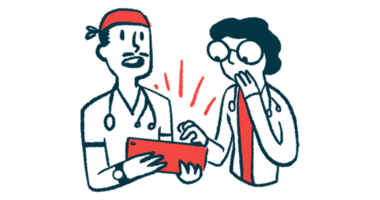Why the meaning of ‘normal’ is different in our family
Our son with joint damage has a life that's not the way everyone lives

I took my youngest son, Caeleb, to the train station near our home this morning. He rides from our little town to downtown Albuquerque, about 30 miles from our house, to the University of New Mexico campus, where he’s a student. He has hemophilia and chooses not to drive. The whole trip takes about 45 minutes total.
Physical therapy and mobility assistance, such as a walking cane or wheelchair, are crucial for Caeleb to get to classes on days when the pain in his right knee and ankle proves too much to bear. That chronic pain, a result of the damage from excessive internal bleeding episodes in his joints, significantly affects his mobility and daily activities. The bleeds eroded the cartilage in the two joints in his right leg, leaving him with mobility issues that we never imagined we’d face.
When I dropped Caeleb off at the train station this morning, he turned to put his walking stick back into my car. He told me he didn’t need help today, so he shut the door without it and boarded the train. I looked at Caeleb’s stick in my car and thought, “Oh, great! Caeleb can have a normal day.” I immediately chastised myself as I used a word — “normal” — that seems to bother me more and more. I felt ashamed as I silently inferred that anything less than walking without assistance wasn’t “normal.”
The truth is that medical equipment can imply that something is faulty, that Caeleb isn’t “normal” because he depends on assistance to walk. My quick judgment about my son, or anyone, lacks reason and compassion. My awful thoughts assume that there’s one type of “normal,” and anyone not identifying with my impulse assumption doesn’t match the definition of normality.
How our definitions have changed
I felt ashamed because my inner thoughts were misguided. Why did I confine my son to a narrow definition of “normal”? What’s become traditional in my family isn’t the same for everyone. Many families don’t grapple with internal bleeding into joints or the need for medical assistance with walking. Some of us, such as Caeleb, depend on help to participate in daily activities. That “normal” includes walking sticks or wheelchairs. With help, people like Caeleb complete tasks that many others take for granted.
There are good reasons to pay attention to what most people consider “normal.” Doctors provided us with the diagnosis of a bleeding disorder because scientific research has determined the “normal” range of clotting activity. The amount of medication prescribed to treat an internal bleeding episode corresponds to the customarily expected outcome found in most cases.
In a more personal example, I know how to administer medication to my son in the easiest way because I observe him with each dose of treatment. He demonstrates what usually makes him less anxious or what I normally do to help my son prepare for an infusion of factor VIII.
When Caeleb was a young boy, he had a horrible fear of needles. He wouldn’t lie still for many infusions to receive his much-needed clotting agent. After fighting with him for years, I suddenly discovered that his problem didn’t involve the needle. When I physically held my son down, he moved and screamed at the top of his lungs. I took away his power over his body. Like the rest of us, he wanted to remain in control.
However, Caeleb’s determination and resilience were evident when he overcame his fear of needles, a significant milestone in his journey toward self-acceptance.
The solution to the problem was a shift in our understanding of “normal.” Before we resorted to another stick, I tried a different approach to prepare him for infusing. I asked him to raise his thumb when he felt ready to start. It took up to an hour for his thumb to come up, but from that day on, we never had an issue with a stick if he could raise or lower his thumb. Our “normal” transformed from resistance to acceptance, teaching us that “normal” is a flexible concept.
Looking at Caeleb’s walking stick, I couldn’t help but admire his resilience. At 19, he faces chronic pain because of complications from his hemophilia. Yet he doesn’t let his struggles hinder his dreams. He refuses to be defined by his condition, and I have profound gratitude. Caeleb redefines “normal” by adapting and taking on the world.
Note: Hemophilia News Today is strictly a news and information website about the disease. It does not provide medical advice, diagnosis, or treatment. This content is not intended to be a substitute for professional medical advice, diagnosis, or treatment. Always seek the advice of your physician or another qualified health provider with any questions you may have regarding a medical condition. Never disregard professional medical advice or delay in seeking it because of something you have read on this website. The opinions expressed in this column are not those of Hemophilia News Today or its parent company, Bionews, and are intended to spark discussion about issues pertaining to hemophilia.








Raymond W Stanhope
The term normal has always been a relative term as in what is normal or who's normal. For me it has never been about normal but whether or not it was a good day. In your story I would have celebrated that Caleb had a good day when he left his walking stick behind in the car. This is something that all of us could understand because all of us go through good and bad days, this can encompass a wide range of things that could impact anyone, this is our shared humanity. There is a point in this article where boundaries between normal and routine seem to blur for me. However, thanks for sharing.
Mary Lou Cameron
Joe, it is good to hear from you. I admire your letting others of us have a little more information and understanding of your family's situation. Your family is in our prayers.
Sharon Henson
Today we see words and conversations very differently. I am from the "old school" where those words didn't provoke a response, it was just accepted as vocabulary.........normal and disabled. I had 4 brothers, 3 with Hemophilia and we did use those terms and no one thought a thing about it because it was "normal" speech. I just have memories of my brothers pain in the night hurting with huge purple bruises in their elbow, knee, ankle, shoulder etc. and I just think of them as hurting, neither normal or disabled.